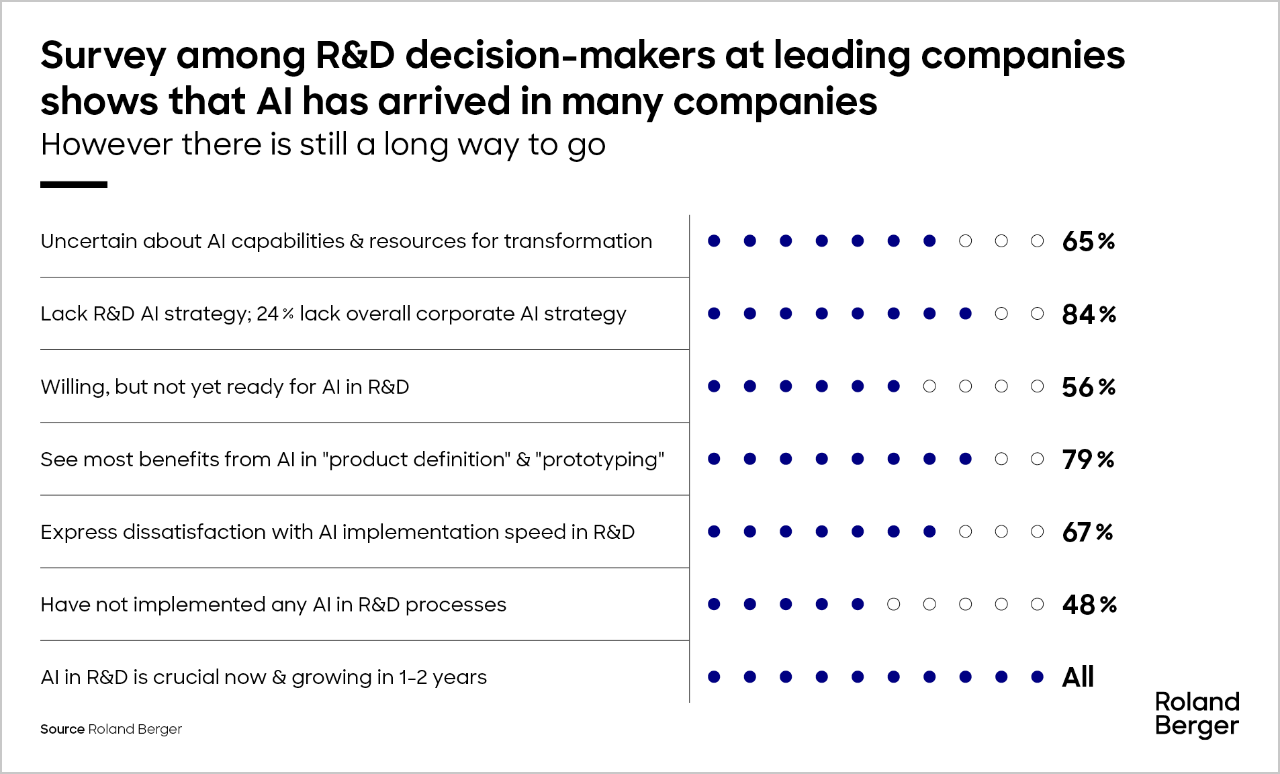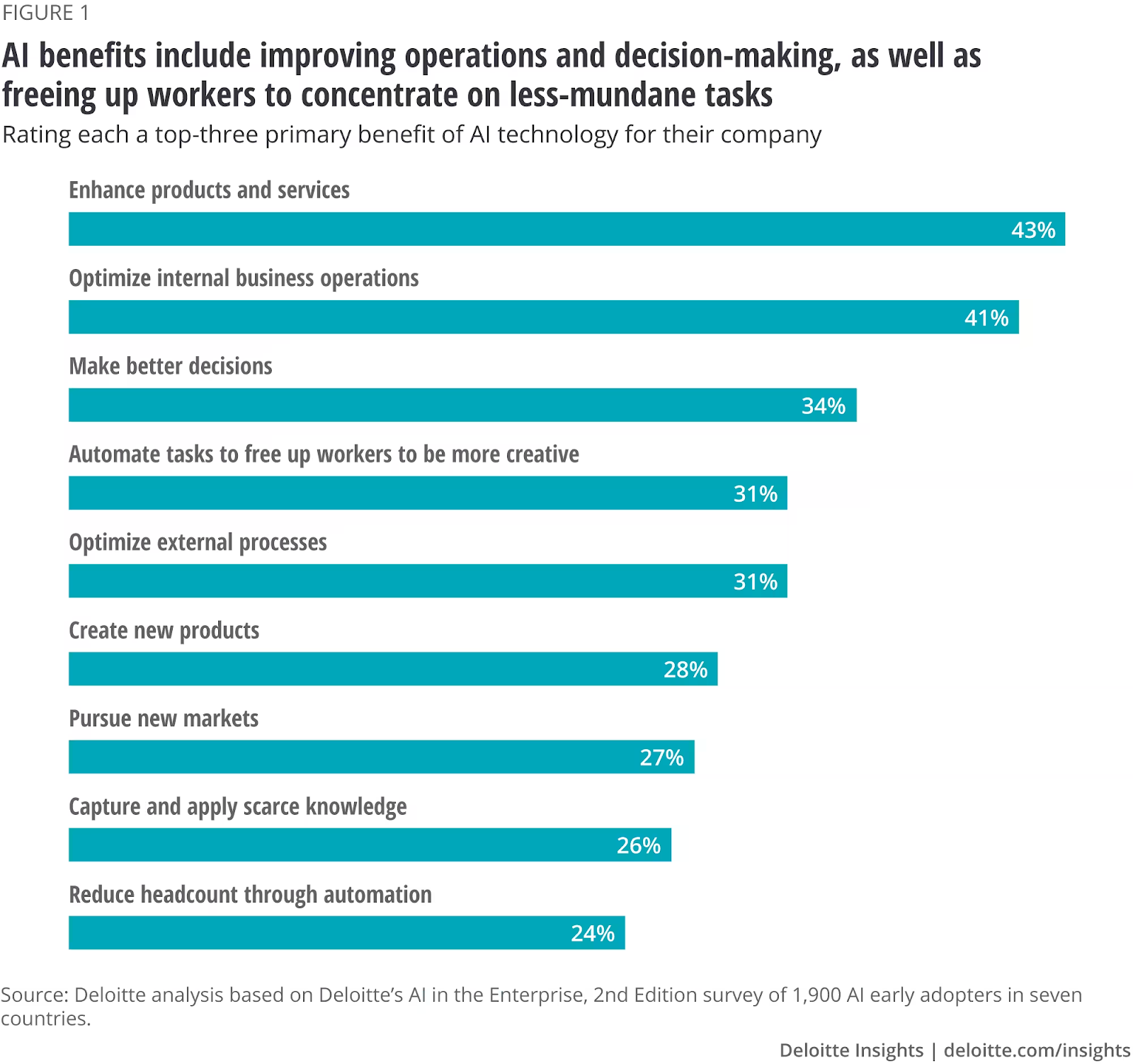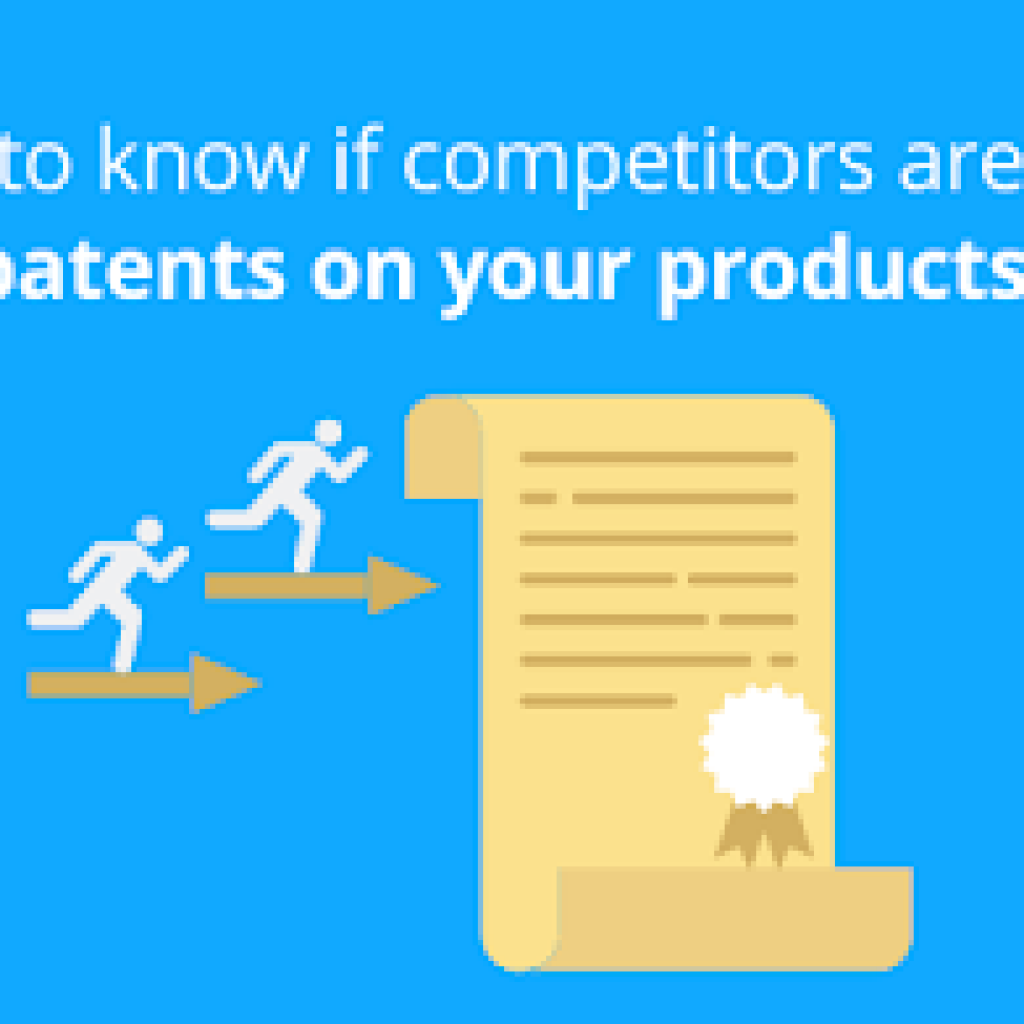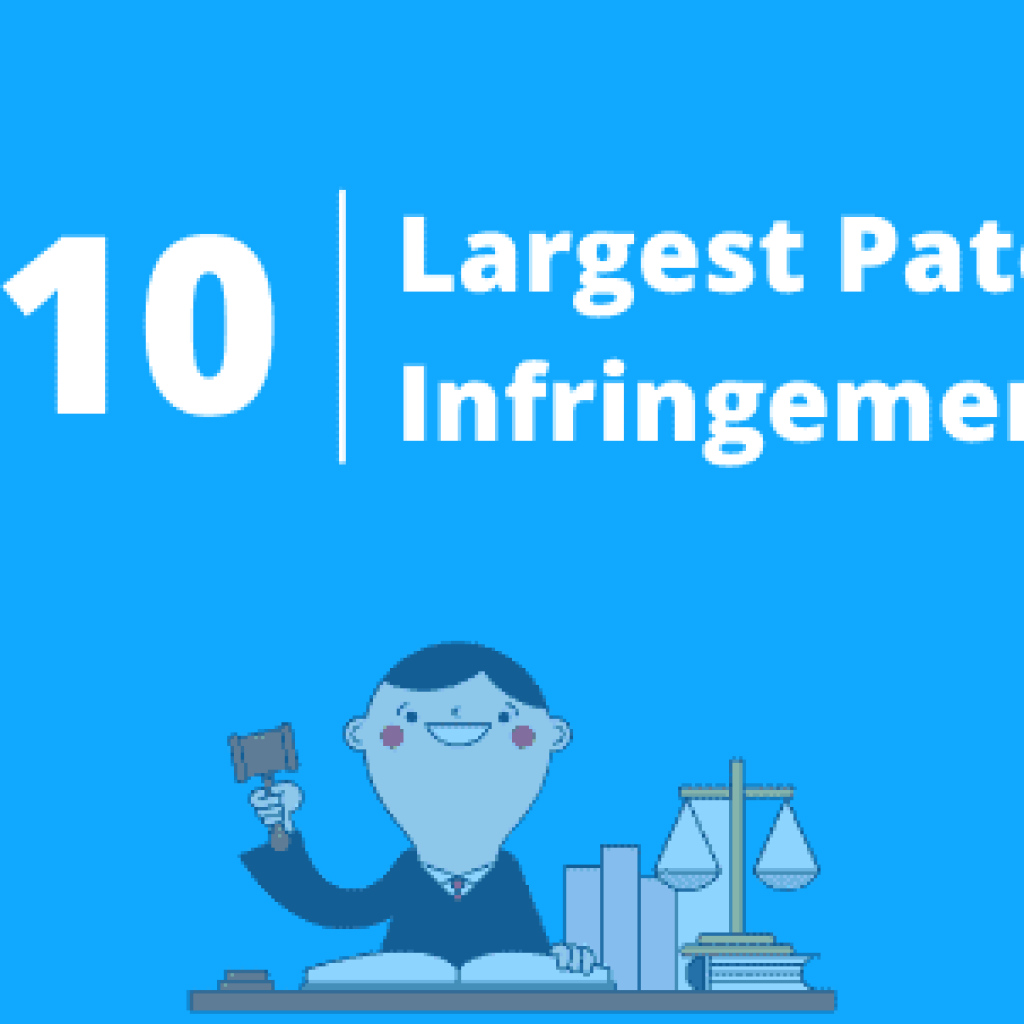Research and development have always evolved with time. Yet nothing comes close to the transformative shift the adoption of AI in R&D has brought. The increased rapid development of R&D is pushing companies to find faster and more efficient ways to develop breakthroughs.
Traditional, lengthy, and complex processes cannot cope with this urgency, demanding more streamlined and innovative approaches.
According to a Roland Berger survey, 84% of companies do not have an R&D AI strategy despite acknowledging the importance of AI. In comparison, 56% are willing but not ready to implement AI in R&D.
The main barriers include fear of the unknown and lack of understanding, expertise, and resources. Additionally, 65% of company representatives are unsure about the AI capabilities and resources required for transformation.

Bringing new and innovative products to market through R&D is more challenging than ever. Many industries face increasing competitive pressure from new market entries, rising customer expectations, and stricter regulatory requirements.
However, emerging use cases of AI in R&D, such as finding answers to research questions quickly and accurately and identifying gaps and opportunities for research and patent screening, will cut product development time by over 60% in the next couple of years. Additionally, companies will see more patents filed, lower R&D costs, reduced research time, and other benefits.
Therefore, despite the uncertainties, it’s clear that AI will bring big changes to R&D departments, potentially boosting productivity and inspiring more innovation.
Current State of Research
First, let’s navigate through the current state of research. Imagine sifting through tons of data, deciphering patent jargon manually, and conducting keyword searches that feel more like a daunting task. Traditional research methods feel outdated and inadequate for today’s challenges in R&D.
Traditional research methodologies, such as manual review of patents and research papers, static document analysis, and manual keyword searches, have their limitations.
These methods are time-consuming, prone to errors, and often fail to provide a holistic understanding of the research landscape. As research practices evolve, there is an urgent need for innovative solutions to overcome these challenges. It’s time for a revolution, and AI is leading the charge with its innovative approach.
How AI Transforms R&D
Innovation Acceleration
AI in R&D accelerates innovation by providing insights in minutes, allowing researchers to focus on more complex and creative aspects of their work.
Pharmaceutical companies are leveraging AI to accelerate drug discovery and bring life-saving medications to market. According to McKinsey, it typically takes around 12 years to bring a drug candidate from concept to market. Biolexis Therapeutics aims to leverage AI to develop weight loss and diabetes drugs that could enter clinical trials in just 1.5 years.
Accuracy and Reliability of Results
AI eliminates the guesswork, data discrepancies, or subjective biases that cloud the findings and fine-tune the results. With its ability to analyze large datasets accurately, AI gives reliable results with citations to actual resources, helping in making better decisions backed by data.
For example, Cradle’s AI technology increases the chances of success of specific R&D programs. Its generative AI capabilities can find solutions to protein engineering challenges that humans are not capable of finding with existing tools.
Cost Reduction
Research and development can be expensive. The longer it continues, the more resources it consumes. AI streamlines this, leading to significant cost savings. According to a Bain & Company survey, 40% of pharma companies have included expected savings from generative artificial intelligence in their 2024 budgets. This makes AI not only a strategic asset but also a cost-effective one.

Competitive Advantage
Organizations using AI in R&D are gaining a competitive edge by swiftly identifying trends, opportunities, and potential risks, enabling them to stay ahead in their respective fields. Many companies, including Mankind, Sun Pharma, and Piramal, use AI tools like Pharsight to track competitors’ drug patents.
Meanwhile, Slate Pro provides researchers with clear and actionable insights, empowering them to drive innovative breakthroughs and maintain a competitive edge by monitoring competitors, what they are doing, and how.
Accelerated Data Discovery
Research is a race against time. With its lightning-fast algorithms, AI turns the tedious task of data discovery into a sprint, ensuring that no nugget of valuable information goes unnoticed.
Slate Pro is a great example of an AI research tool designed specifically for R&D data discovery. It analyzes large datasets of technical literature, such as patents and research papers, to ensure a thorough data discovery process. It helps to tackle critical research questions by providing fast, precise answers from millions of documents. This isn’t just about speed. It’s about having access to crucial insights that can drive innovation and solve complex problems.
Strategic Decision Making
Decisions are only as good as the information they’re based on. AI transforms decision-making from a guessing game into a strategic outcome backed by data-driven insights.
Beyond automating tasks, the other more remarkable impact of AI on an enterprise will be on decision-making: Large organizations still struggle to make good decisions on time.
Jay Dwivedi, President, XInvest Consultants
According to a Deloitte survey, 34% of people believe AI helped them make better decisions at work and free them from repetitive tasks.

Fast Research Process
The era of waiting for insights is over. With AI, research processes are not just fast; they’re instantaneous. The luxury of time becomes an ally, not a constraint.
For instance, biotech startup Cradle uses generative AI to speed up protein design and optimization. Results so far indicate that Cradle’s technology significantly accelerates protein design and optimization with fewer, more successful experiments. Most projects advance twice as fast with Cradle’s platform compared to industry standards.
Removal of Human Error and Bias
Humans can make errors; AI doesn’t. By removing the human touchpoints that introduce biases and errors, AI ensures that research outcomes are not just accurate but indisputably reliable. A National Library of Medicine (NLM) study highlights that the AI-based evaluation detected 534 out of 560 pneumonia cases (95.4%). In 132 CRs, the DL algorithm detected opacifications/consolidations, whereas radiologists did not.
The most straight-forward benefit of utilizing Slate Pro to find answers to research questions is minimizing the potential for human error. Manual extraction of insights leads to missed critical information, hours spent searching for the latest and relevant papers, and other hard-to-detect errors that hinder analysis. Slate Pro eliminates these risks and offers extra protection against human error and bias during research.
Insights in One-Click
AI research tools like Slate Pro streamline R&D processes, providing researchers with actionable insights in a single click of a button. Just ask your question to the AI search engine and get your answer instantly.
But, as with any revolution, there are challenges to face.
Challenges of Using AI in Research
Quality of Data
The noisy, chaotic nature of unstructured data can be a hurdle. Dealing with that data impacts the effectiveness of AI-driven search algorithms, leading to inaccurate or incomplete results. Investing in advanced data preprocessing techniques is essential to enhance the quality of input data.
Ethical and Privacy Concerns
The use of AI in data discovery raises ethical and privacy concerns, especially when dealing with sensitive information. Robust ethical guidelines and privacy measures are the anchors of this technological evolution.
T-Mobile, a major wireless network operator, has experienced multiple data breaches, nine in the last five years. Earlier this year, T-Mobile disclosed that 37 million customer records were stolen in a breach that started in November 2022.
The company’s AI analysts revealed that the attacker used an API with AI capabilities to gain unauthorized access. This led to the theft and exposure of sensitive customer information, including full names, contact numbers, and PINs.
Interpretability of Results
Understanding and interpreting the results generated by AI-driven search algorithms can be challenging, particularly when dealing with complex or large datasets. AI tools provide result interpretation and insights into how AI systems arrive at specific conclusions, making the decision-making process more transparent.
Future Prospects of AI in R&D
Advanced Automation
A Deloitte survey found that 31% of companies prefer automating tasks with AI to free workers to be more creative. Future AI advancements will lead to even more automated processes, allowing researchers to focus on high-level decision-making and creative aspects.
For example, AI tools like Pharsight automates tracking drug patent expiration and form future strategies accordingly.
AI Evolution within R&D Sectors
Integrating quantum computing with AI could speed up complex simulations significantly, especially in fields like material science and pharmacology. As AI algorithms become more transparent and easier to understand, researchers will be able to trust the conclusions drawn by AI in R&D. This integration has the potential to open up new possibilities and horizons for scientific research.
Interdisciplinary Breakthroughs
AI encourages interdisciplinary collaborations across different research areas, breaking down barriers between fields and sparking new ideas. AI will help researchers communicate better by translating technical terms and jargon between disciplines. This will allow researchers to integrate discoveries from different fields faster, leading to more innovative breakthroughs.
For instance, Slate Pro (AI research tool) helps researchers easily get answers and solutions to innovation challenges. The platform provides access to accurate, reliable information and encourages R&D teams to focus on innovative breakthroughs.
Human-Machine Partnership
AI won’t replace human researchers; it’ll enhance their abilities. Across industries, organizations see some jobs as teamwork between humans and AI. Deloitte researchers suggest rethinking work not as a set of tasks arranged in a predefined process but as a collaborative effort in which “humans define the problems, machines help find the solutions, and humans verify the acceptability of those solutions.”
For example, Google AI has developed a deep learning tool called LYmph Node Assistant (LYNA) to spot metastatic cancer. It’s trained on detailed pathology slides of lymph nodes from breast cancer patients. LYNA has shown impressive results, detecting 92.4% of tumors compared to 73.2% by human pathologists. It also identifies suspicious tissue areas that are too small for humans to notice accurately.
LYNA could help pathologists by flagging areas needing further human review and diagnosis. In tests, six pathologists saw their slide review time reduced from about two minutes to one minute per slide with LYNA’s assistance.
Ready to Transform Your R&D Process with AI?
AI is significantly impacting R&D, helping professionals work faster, more accurately, and cost-effectively. Integrating AI in research processes lets you focus on what you do best—innovate.
With Slate Pro, companies can effectively use AI in their R&D process. It helps sift through millions of patents and research papers, providing multiple data-backed solutions to complex research challenges with proper citations. Accessing vast information across every domain effortlessly ensures researchers never miss crucial details, significantly enhancing the accuracy and speed of their work.
Join hundreds of R&D professionals already using Slate Pro to enhance their work and see the difference AI can make in your research.
Authored By – Shrey Gupta, Product Marketing










